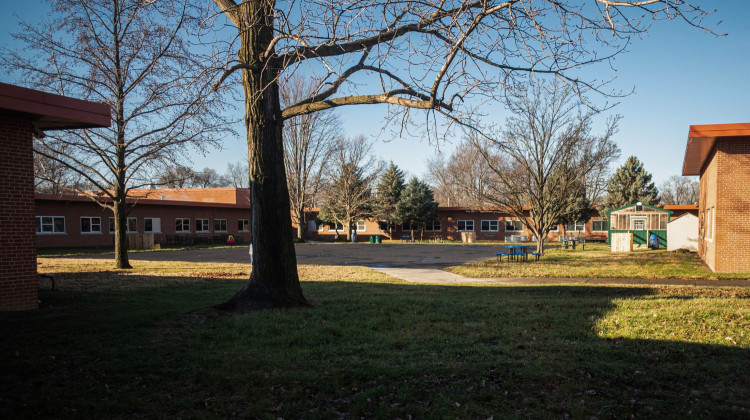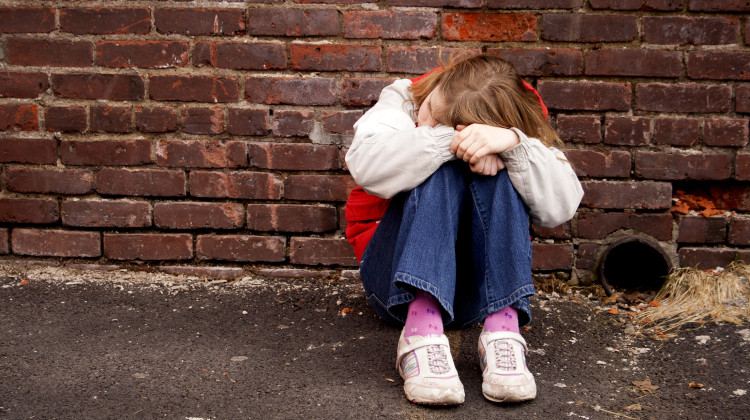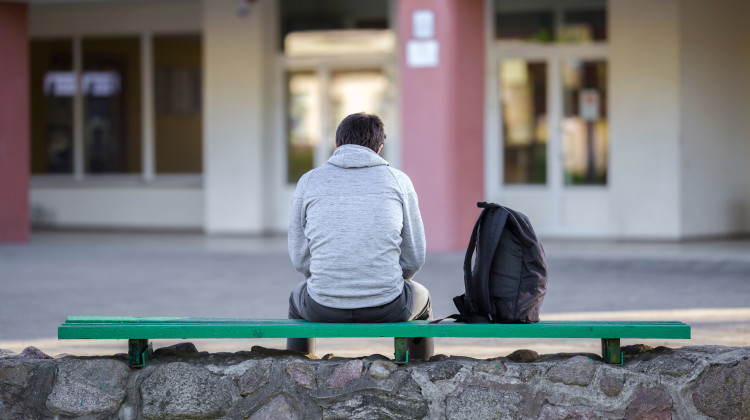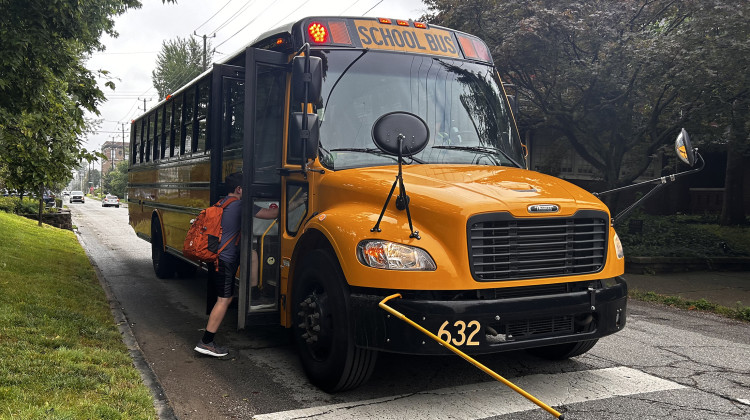
The courtyard Dec. 17, 2024, at the temporary location of the Indiana School for the Blind and Visually Impaired.
Nate Pappas for Mirror IndyWhen the Indiana School for the Blind and Visually Impaired relocated to Indy’s far east side this year, there were naturally a lot of questions.
Would the new facilities accommodate the students’ needs? How would the students get to the new campus from the current one on 42nd Street? And would they lose some students in the transition?
But for Jazmine Nelson, a junior who has attended the school since 2018, the move to the school’s temporary location in a former IPS school has brought unexpected benefits.
“At the last campus that we were all at, it was all separated — like elementary was in a building, middle school, high school was in a building,” she said. “Having everyone put together kind of brings us closer as a school and as more of a community.”
The move took place at the start of the school year as part of a $655 million project to combine the campuses of the state’s school for blind and low vision learners and the Indiana School for the Deaf.
Together, both schools will see the construction of new, state-of-the-art facilities tailored to the needs of their students. For example, educators have requested dimmable lighting to accommodate kids with light sensitivity and high-contrast floor and hallway designs to help low vision students easily identify their place in a building.
It will be the first time either school has seen significant renovations in 25 years.
“Sometimes it’s a little pressure thinking about how we’re trying to build this building for the next 100 years,” Principal Jay Wilson said, “but it’s been a good and interesting process.”
Designing a new campus
The Indiana School for the Blind enrolls more than 100 kids a year in pre-K through 12th grade. The school serves students from across the state and about 30 of its students, this year, live on campus.
Indiana lawmakers have dedicated $465 million to the project through state appropriations. Another $190 million is being financed through federal pandemic relief dollars. Officials broke ground on a combined campus in August.
Plans call for moving the Indiana School for the Deaf from its 42nd Street campus just north of the Indiana State Fairgrounds to a shared location at the 75th Street and College Avenue campus where the Indiana School for the Blind has taught students since 1930.
Both schools house students from across the state in on-campus residential buildings and will see the construction of new dorms.

Additionally, a new academic center, fieldhouse, athletic fields and greenhouse will be built on the sprawling, 67-acre campus. Other existing structures, such as the school’s administration building and bell tower, will be renovated.
Though the two schools will share a campus, each will have its own dedicated space. Students and staff from both schools have met with architects to describe what they would like in the new campus.
Local firms Ratio Design and American Structurepoint also have enlisted the help of two renowned accessibility experts — architects Chris Downey, who is blind, and John Dickinson, who is deaf.
James Michaels, superintendent of the Indiana School for the Blind, said he appreciates the understanding the two architects bring to the project. The team, for example, has brought tactile versions of their drawings to meetings with Michaels, who is blind, so he can better follow along as they describe their work.
“They have perspective from their own experiences,” Michaels said. “They really have done a lot of things to help me understand what the campus is going to look like.”
Settling into temporary space
Indiana School for the Deaf students are able to attend classes as they normally would through the construction.
But students of the Indiana School for the Blind are taking classes at IPS’ former George Buck School 94. Some support offices have been moved to another closed IPS school, Floro Torrence School 83. Residential students are staying in dorms on the Indiana School for the Deaf campus.
The transition to the temporary space required some adjustments. Braille lettering was placed outside each door, cane holders were installed in classrooms and high contrast markings were added to doors frames to increase their visibility. However, Principal Jay Wilson said, overall changes were minimal.
“Our overall philosophy is that our students, once they leave us, go into a world that is a sighted world,” Wilson said. “So actually it’s a good, real-life lesson.”

To accommodate students, Indiana School for the Blind and Visually Impaired classes typically have far fewer students assigned to each classroom. That means the spaces at School 94 felt especially roomy to the students and teachers.
They might be relocated for three to five years — depending on how long construction takes — so school leaders are taking steps to make School 94 feel like their own. A greenhouse was built in an enclosed courtyard and school leaders say they’re also excited to offer new classes this spring in a recently finished adaptive kitchen.
The kitchen features countertops of varying heights, no-burn cooktops and tactile markings on appliances. School leaders say they will take some of the donated materials when they move back to the original campus.
The biggest challenge so far, Wilson said, has been a lack of office space.
With occupational and physical therapy programs on site, the school employs far more adult staff than a traditional school. That means converting classrooms to temporary offices was an early priority during the temporary relocation.
“It’s a new normal for us,” Wilson said. “Sometimes kids can be more adjustable than adults, but I think everybody has done a good job of assimilating to a new normal.”
Listening to students
Nelson, who is a residential student from northwest Indiana, said she’s grown more accustomed to the daily commute from the dorms on 42nd Street to the Indiana School for the Blind’s eastside school building.
The 15-year-old has some vision but struggles to make out colors and details. She described her experiences with vision as being like “you’re watching a really old movie that doesn’t have color yet.” Those differences, she said, stand out in a traditional classroom.
She tried returning to her traditional public school for a brief period this year, but found the Indiana School for the Blind could better accommodate her needs for specific materials. And, the school’s high contrast hallways were easier to navigate.
“There’s still times where the lights in the classroom are too bright,” Nelson said, “But, here, I feel like the teachers understand you a lot more.”

At the Indiana School for the Blind, she also is able to participate in cheer, track and forensics. Nelson is interested in becoming a teacher or psychologist, and she’s getting experience working with elementary students at the school, teaching them about braille and voiceover technology.
That’s all become easier now that students of all ages are in the same building.
“I’m just able to, like, walk down a hallway and turn a corner, and it’s right there,” she said.
The junior will graduate long before the campus redesign is finished, but she had a chance to share her ideas with architects as they began designing new buildings.
Her requests? More dimmable lighting, common areas and suite-style dorms in student residence halls.
“I’m sad that I won’t be able to experience it,” Nelson said. “However, I’m grateful that I’m able to contribute to other students’ experiences and being able to be in a school that was designed with their ambitions and dreams in mind.”
The Indiana Blind Children’s Foundation, a nonprofit that supports the school, will have a fundraiser March 1. The 2025 No Limits Celebration at Butler’s Schrott Center for the Arts will feature a performance by Lachi, a globally touring performing artist who was born legally blind.
Doors open for a reception at 6 p.m. A one-hour concert will begin at 8 p.m. followed by deserts and a Q&A with Lachi. Tickets start at $50 and are available online.
Mirror Indy reporter Carley Lanich covers early childhood and K-12 education. Contact her at carley.lanich@mirrorindy.org or follow her on X @carleylanich.
This article first appeared on Mirror Indy and is republished here under a Creative Commons license.
 DONATE
DONATE






 Support WFYI. We can't do it without you.
Support WFYI. We can't do it without you.